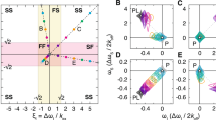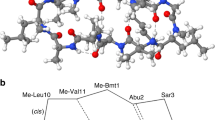Abstract
We present a simple method, ARTSY, for extracting 1JNH couplings and 1H–15N RDCs from an interleaved set of two-dimensional 1H–15N TROSY-HSQC spectra, based on the principle of quantitative J correlation. The primary advantage of the ARTSY method over other methods is the ability to measure couplings without scaling peak positions or altering the narrow line widths characteristic of TROSY spectra. Accuracy of the method is demonstrated for the model system GB3. Application to the catalytic core domain of HIV integrase, a 36 kDa homodimer with unfavorable spectral characteristics, demonstrates its practical utility. Precision of the RDC measurement is limited by the signal-to-noise ratio, S/N, achievable in the 2D TROSY-HSQC spectrum, and is approximately given by 30/(S/N) Hz.



Similar content being viewed by others
References
Arbogast L, Majumdar A, Tolman JR (2010) HNCO-based measurement of one-bond amide N-15-H-1 couplings with optimized precision. J Biomol NMR 46:175–189
Bax A (2003) Weak alignment offers new NMR opportunities to study protein structure and dynamics. Protein Sci 12:1–16
Bax A, Grishaev A (2005) Weak alignment NMR: a hawk-eyed view of biomolecular structure. Curr Opin Struct Biol 15:563–570
Bax A, Vuister GW, Grzesiek S, Delaglio F, Wang AC, Tschudin R, Zhu G (1994) Measurement of homo- and heteronuclear J couplings from quantitative J correlation. Methods Enzymol 239:79–125
Bhattacharya A, Revington M, Zuiderweg ERP (2010) Measurement and interpretation of N-15-H-1 residual dipolar couplings in larger proteins. J Magn Reson 203:11–28
Boisbouvier J, Delaglio F, Bax A (2003) Direct observation of dipolar couplings between distant protons in weakly aligned nucleic acids. Proc Natl Acad Sci USA 100:11333–11338
Bujacz G, Alexandratos J, ZhouLiu Q, ClementMella C, Wlodawer A (1996) The catalytic domain of human immunodeficiency virus integrase: ordered active site in the F185H mutant. FEBS Lett 398:175–178
Chen JCH, Krucinski J, Miercke LJW, Finer-Moore JS, Tang AH, Leavitt AD, Stroud RM (2000) Crystal structure of the HIV-1 integrase catalytic core and C-terminal domains: a model for viral DNA binding. Proc Natl Acad Sci USA 97:8233–8238
Delaglio F, Grzesiek S, Vuister GW, Zhu G, Pfeifer J, Bax A (1995) NMRpipe—a multidimensional spectral processing system based on Unix pipes. J Biomol NMR 6:277–293
Dyda F, Hickman AB, Jenkins TM, Engelman A, Craigie R, Davies DR (1994) Crystal structure of the catalytic domain of HIV-1 integrase—similarity to other polynucleotidyl transferases. Science 266:1981–1986
Fitzkee NC, Masse JE, Shen Y, Davies DR, Bax A (2010) Solution conformation and dynamics of the HIV-1 integrase core domain. J Biol Chem 285:18072–18084
Freeman R, Kempsell SP, Levitt MH (1980) Radiofrequency pulse sequences which compensate their own imperfections. J Magn Reson 38:453–479
Goldgur Y, Dyda F, Hickman AB, Jenkins TM, Craigie R, Davies DR (1998) Three new structures of the core domain of HIV-1 integrase: an active site that binds magnesium. Proc Natl Acad Sci USA 95:9150–9154
Kay LE, Keifer P, Saarinen T (1992) Pure absorption gradient enhanced heteronuclear single quantum correlation spectroscopy with improved sensitivity. J Am Chem Soc 114:10663–10665
Kontaxis G, Clore GM, Bax A (2000) Evaluation of cross-correlation effects and measurements of one-bond couplings in proteins with short transverse relaxation times. J Magn Reson 143:184–196
Lerche MH, Meissner A, Poulsen FM, Sorensen OW (1999) Pulse sequences for measurement of one-bond N-15-H-1 coupling constants in the protein backbone. J Magn Reson 140:259–263
Mantylahti S, Koskela O, Jiang P, Permi P (2010) MQ-HNCO-TROSY for the measurement of scalar and residual dipolar couplings in larger proteins: application to a 557-residue IgFLNa16–21. J Biomol NMR 47:183–194
Morris GA, Freeman R (1979) Enhancement of nuclear magnetic resonance signals by polarization transfer. J Am Chem Soc 101:760–762
Ottiger M, Delaglio F, Bax A (1998) Measurement of J and dipolar couplings from simplified two-dimensional NMR spectra. J Magn Reson 131:373–378
Otting G, Widmer H, Wagner G, Wüthrich K (1986) Origin of t 1 and t 2 ridges in 2D NMR spectra and procedures for suppression. J Magn Reson 66:187–193
Permi P, Rosevear PR, Annila A (2000) A set of HNCO-based experiments for measurement of residual dipolar couplings in N-15, C-13, (H-2)-labeled proteins. J Biomol NMR 17:43–54
Pervushin K, Riek R, Wider G, Wuthrich K (1997) Attenuated T2 relaxation by mutual cancellation of dipole- dipole coupling and chemical shift anisotropy indicates an avenue to NMR structures of very large biological macromolecules in solution. Proc Natl Acad Sci USA 94:12366–12371
Pervushin KV, Wider G, Wuthrich K (1998) Single transition-to-single transition polarization transfer (ST2-PT) in [N15, H1]-TROSY. J Biomol NMR 12:345–348
Piotto M, Saudek V, Sklenár V (1992) Gradient-tailored excitation for single-quantum NMR spectroscopy of aqueous solutions. J Biomol NMR 2:661–665
Prestegard JH, Al-Hashimi HM, Tolman JR (2000) NMR structures of biomolecules using field oriented media and residual dipolar couplings. Q Rev Biophys 33:371–424
Ruckert M, Otting G (2000) Alignment of biological macromolecules in novel nonionic liquid crystalline media for NMR experiments. J Am Chem Soc 122:7793–7797
Schulte-Herbruggen T, Sorensen OW (2000) Clean TROSY: compensation for relaxation-induced artifacts. J Magn Reson 144:123–128
Tjandra N, Bax A (1997) Direct measurement of distances and angles in biomolecules by NMR in a dilute liquid crystalline medium. Science 278:1111–1114
Tjandra N, Grzesiek S, Bax A (1996) Magnetic field dependence of nitrogen-proton J splittings in N- 15-enriched human ubiquitin resulting from relaxation interference and residual dipolar coupling. J Am Chem Soc 118:6264–6272
Tolman JR, Prestegard JH (1996) A quantitative J-correlation experiment for the accurate measurement of one-bond amide N-15-H-1 couplings in proteins. J Magn Reson B 112:245–252
Tolman JR, Ruan K (2006) NMR residual dipolar couplings as probes of biomolecular dynamics. Chem Rev 106:1720–1736
Tolman JR, Flanagan JM, Kennedy MA, Prestegard JH (1995) Nuclear magnetic dipole interactions in field-oriented proteins—information for structure determination in solution. Proc Natl Acad Sci USA 92:9279–9283
Tugarinov V, Kay LE (2003) Quantitative NMR studies of high molecular weight proteins: application to domain orientation and ligand binding in the 723 residue enzyme malate synthase G. J Mol Biol 327:1121–1133
Ulmer TS, Ramirez BE, Delaglio F, Bax A (2003) Evaluation of backbone proton positions and dynamics in a small protein by liquid crystal NMR spectroscopy. J Am Chem Soc 125:9179–9191
Vijayan V, Zweckstetter M (2005) Simultaneous measurement of protein one-bond residual dipolar couplings without increased resonance overlap. J Magn Reson 174:245–253
Yang DW, Venters RA, Mueller GA, Choy WY, Kay LE (1999) TROSY-based HNCO pulse sequences for the measurement of (HN)-H-1-N-15, N-15-(CO)-C-13, (HN)-H-1-(CO)-C-13, (CO)-C-13-C-13(alpha) and (HN)-H-1-C-13(alpha) dipolar couplings in N-15, C-13, H-2-labeled proteins. J Biomol NMR 14:333–343
Yao LS, Ying JF, Bax A (2009) Improved accuracy of N-15-H-1 scalar and residual dipolar couplings from gradient-enhanced IPAP-HSQC experiments on protonated proteins. J Biomol NMR 43:161–170
Yao LS, Grishaev A, Cornilescu G, Bax A (2010a) The impact of hydrogen bonding on amide 1H chemical shift anisotropy studied by cross-correlated relaxation and liquid crystal NMR spectroscopy. J Am Chem Soc 132. doi:10.1021/ja103629e
Yao L, Grishaev A, Cornilescu G, Bax A (2010b) Site-specific backbone amide 15 N chemical shift anisotropy tensors in a small protein from liquid crystal and cross-correlated relaxation measurements. J Am Chem Soc 132:4295–4309
Zhu G, Torchia DA, Bax A (1993) Discrete Fourier transformation of NMR signals. The relationship between sampling delay time and spectral baseline. J Magn Reson Ser A 105:219–222
Acknowledgments
We thank Alexander Maltsev for the sample of perdeuterated GB3 and for help in preparing the liquid crystalline solution for IN50–212 measurement, and Lishan Yao for the protonated GB3 mutant. This work was supported in part by the Intramural Research Program of the NIDDK, NIH, and by the Intramural AIDS-Targeted Antiviral Program of the Office of the Director, NIH.
Author information
Authors and Affiliations
Corresponding author
Electronic supplementary material
Below is the link to the electronic supplementary material.
Rights and permissions
About this article
Cite this article
Fitzkee, N.C., Bax, A. Facile measurement of 1H–15N residual dipolar couplings in larger perdeuterated proteins. J Biomol NMR 48, 65–70 (2010). https://doi.org/10.1007/s10858-010-9441-9
Received:
Accepted:
Published:
Issue Date:
DOI: https://doi.org/10.1007/s10858-010-9441-9




